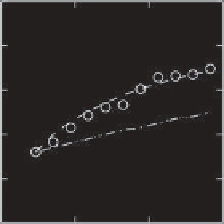Geoscience Reference
In-Depth Information
10
0
10
8
6
ω
0
ω
0
(60)
R
max
(cm)
4
10
-1
2
0
0
0.5
1
1.5
0
0.5
1
1.5
t
/
T
E
t
/
T
E
Figure 7.7.
Time evolution of the sink vortex parameters while decaying over a flat bottom mainly due to Ekman friction. Adapted
from
Zavala Sansón and van Heijst
[2000a]. Left: Radius of maximum velocity
R
max
(left). Right: Normalized peak vorticity
ω
0
.
Circles denote experimental measurements. The dashed line represents a numerical simulation using the vorticity equation (7.17),
the dashed-dotted line is a simulation using only linear Ekman damping, and the dotted line represents the case with no Ekman
effects. (60) denotes initial parameters 60 s after the forcing was stopped. The fluid depth is 18 cm.
higher-order terms is that the decay rate of cyclonic and
anticyclonic fluid columns is different, i.e., the nonlin-
ear Ekman corrections predict an asymmetry between
cyclones and anticyclones. This is better appreciated by
omitting lateral viscous effects and the Jacobian term
and considering only the linear and nonlinear Ekman
contributions at the right-hand side of (7.17):
∂ω
∂t
=
bottom, the evolution of these structures is stable, i.e., the
vortices maintain their initially circular shape while being
dissipated. The decay is characterized by an increase of
the radius of maximum azimuthal velocity
R
, while the
peak vorticity
ω
0
decays. These two parameters are shown
in Figure 7.7, where the experimental measurements are
compared with three different numerical simulations: (i)
the general model (7.17) (using a flat bottom or constant
depth
h
1
2
E
2
ω(ω
+
f )
.
−
(7.25)
H
), (ii) the same equation but only including
linear Ekman friction, and (iii) with no Ekman effects.
Evidently, the simulations including nonlinear Ekman
corrections simulate the observations in a much more
effective way than just using the conventional linear term.
The increase of
R
in Figure 7.7a is due to two effects:
lateral friction and nonlinear Ekman terms. Note that the
simulation with linear friction and with no Ekman effects
coincide, which indicates that linear friction does not
contribute to the expansion of the vortex [
García Sánchez
and Ochoa
, 1995]. The decay of the vortex in Figure 7.7b
is enhanced by nonlinear Ekman terms with respect to
linear damping, as suggested by (7.26).
≡
The solution of this equation is
ω
0
exp
(
−
t/T
E
)
ω
=
+1
,
(7.26)
(ω
0
/f )
[
1
−
exp
(
−
t/T
E
)
]
which states a different decay of cyclonic and anticy-
clonic fluid columns. Previous studies have also taken into
account the nonlinear Ekman corrections in the special
case of axisymmetric flows. For instance, the spin up in a
rotating cylinder was examined by
Wedemeyer
[1964]. The
Wedemeyer model considers the azimuthal component of
the Navier-Stokes equation, written in cylindrical coordi-
nates while assuming axisymmetric flow. His results were
later extended by a number of authors in order to study
the spin-down of barotropic vortices [
Kloosterziel and van
Heijst
, 1992;
Maas
, 1993].
Medium-scale rotating facilities are suitable for testing
the Ekman friction theories on the decay of homogeneous
flows. The reason is that the Ekman time scale is long
enough to perform precise measurements of the flow
decay, and short enough to avoid undesired perturbations
during the flow evolution (e.g., the effect of the free
surface).
Zavala Sansón and van Heijst
[2000a] discussed
a series of experiments on the decay of different types
of vortices. For instance, consider an axisymmetric sink
vortex (see Section 7.3.1) generated in a rotating container
sufficiently far away from the lateral walls. Over a flat
7.5. SMALL-SCALE EXPERIMENTS
O
(0.1 M)
Large-scale flows encountered in many environmen-
tal situations, such as those in harbors, groyne fields
of rivers, lakes, and estuaries, are often referred to as
“shallow flows.” The shallowness of the flow domain
suggests that vertical motions in such configurations are
generally much smaller than the large-scale horizontal
motions. This anisotropy of shallow flows gives rise to
an interesting and rich phenomenology. Examples are
the meandering of shallow currents and the formation of
larger circulation cells in semi-enclosed basins [see, e.g.,
Jirka
, 2001;
Jirka and Uijttewaal
, 2004].





















